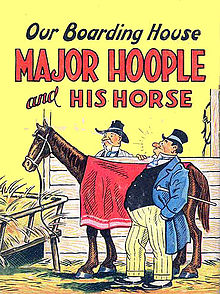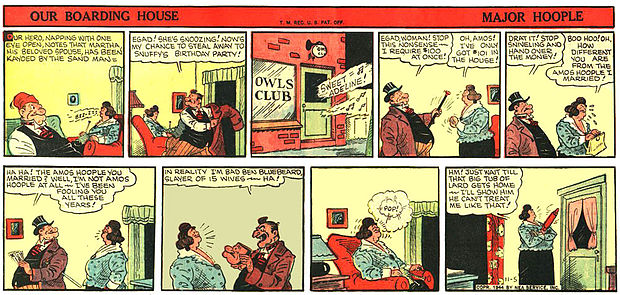- Our Boarding House
-
Our Boarding House was a long-running, American gag-panel comic strip created by Gene Ahern in 1921 and syndicated by Newspaper Enterprise Association. Set in a boarding house run by the sensible Mrs. Hoople, it drew humor from the interactions of her grandiose, tall-tale-telling husband, the self-styled Major Hoople, with the rooming-house denizens and his various friends and cronies.
After Ahern left NEA in March 1936 to create a similar feature a rival syndicate, he was succeeded by a number of artists and writers including Wood Cowan and Bela "Bill" Zaboly before Bill Freyse (1898–1969) took over the art Our Boarding House from 1939 to 1969. He was the father of the American actress Lynn Borden.
Others who worked on the strip included Jim Branagan and Tom McCormick. The Sunday color strip ended on March 29, 1981; the weekday panel continued until December 22, 1984.
Contents
Publication history
In 1921, Gene Ahern created the comic strip Crazy Quilt, starring the Nut Brothers, Ches and Wal. That same year, NEA General Manager Frank Rostock suggested to Ahern that he use a boarding house for a setting.[citation needed] Ahern initially used his own experiences as a boarder while a Chicago, Illinois, art student as grist for his comic mill, and featured the picaresque peccadilloes and bickering of its residents, presided over by the no-nonsense Martha Hoople.[1] Our Boarding House began September 16, 1921,[2] scoring success with readers after the January 1922[citation needed] arrival of the fustian, blustery Major Amos B. Hoople, Martha's husband, who'd returned after some long sojourn. "Hoople has been compared to the type created on-screen by W. C. Fields, but was probably closer to Falstaff," writes comics historian Maurice Horn "A retired military man of dubious achievement like Shakespeare's [comic figure], he boasted of soldierly exploits that were perhaps not all invented, and his buffoonery sometimes concealed real pathos."[1] That character depth diminished as the comic became more popular, with Major Hoople becoming "the one-dimensional figure of fun most people remember" of the strip.[1] The primary boarders were the cynical Clyde and Mack, and the only somewhat more trusting Buster.[1]
A multipanel, color Sunday strip was added in 1924.[1] From October 1931 on, Ahern's The Nut Bros, featuring loony siblings Ches and Wal in pun-filled, vaudevillian bit of business, ran as a topper strip.[1]
Ahern left NEA in March 1936 to create the similar Room and Board for King Features Syndicate, Our Boarding House "passed into the hands of a bewildering array of artists and writers" including Bela "Bill" Zaboly,[1][3] at The Comic Strip Project.[4] before Bill Freyse took over the art for Our Boarding House from 1939 until his death in 1969.[1][5] Writer Bill Braucher scripted from 1939 to 1958,[3] followed by Tom McCormick on the daily from 1959 on. Freyse's 1960s assistant, Jim Branagan, drew the strip from 1969 to 1971,[1][3] succeeded then by Les Carroll.
The Sunday strip came to an end on March 29, 1981, and continued as a daily feature until December 22, 1984,[1] when Carroll and writer Tom McCormick retired.[citation needed] Others included writers Wood Cowan in 1946, Tom Peoples on the Sunday strip circa 1968, and Phil Pastoret on the Sunday strip from 1977 on.[3] The finale had Hoople finally striking it rich: a multimillion dollar project needed a minor patent that he had obtained many years ago. In the last strip, Hoople and Martha embarked upon their new lives of wealth.[citation needed]
Characters and story
As comics historian Don Markstein described the characters:
- Martha scowled a lot, and ran her household the way a Sherman tank might run a stop sign; yet, her boarders, including Buster, Clyde, Mack and others who came and went, managed to hold their own in her presence. But it more likely owes its fame to one character in particular—Martha's husband, Major Amos B. Hoople, perhaps the greatest windbag, stuffed shirt and blowhard ever to "hrumph" his way across the funnies page. It was four months before the Major appeared on the scene (returning from a ten-year absence from Martha's life), but he quickly took over to the point where many people today think his name was the feature's title. Major Hoople had a huge, bulbous nose and an even huger gut. He sported a scraggly moustache and smoked rank cigars. He was seldom seen without a battered fez. In addition to near-archaic expressions like "egad" and "drat", he was often heard mouthing such non-words as "fap", "awp" and "kaff". His favorite mode of expression was long-winded discourses about his prestigious and astonishing experiences, which nobody took seriously and only his occasionally-seen nephew, Alvin, even pretended to pay attention to.[2]
Ahern once revealed the origin of Major Hoople:
- Major Hoople was based on an old fellow I knew quite well when I was growing up. He had been in the Civil War and to hear his tall stories you'd think he had advised Grant and Sherman on every move of the war, telling them exactly what to do every morning. He even insisted he had fired the first shot. He was quite a character and everyone knew him very well. He called himself "General" in spite of the fact that he had only been a top sergeant in the Army. The General was one of those men who always put up a $10 front with a dime in their pockets—a natural subject for cartooning.[6][7]
Reprints
 Saalfield Publishing's Our Boarding House Jumbo Book (1940)
Saalfield Publishing's Our Boarding House Jumbo Book (1940)
There were comic book reprints in Whitman's Crackajack Funnies and a single issue of Standard Comics' Major Hoople Comics (1943).
In 2005, Leonard G. Lee's Algrove Publishing reprinted Ahern's cartoons in Our Boarding House, 1927 as part of its Classic Reprint Series.[8]
In other media
Radio
The Major Hoople radio series began on NBC's Blue Network on June 22, 1942. With Arthur Q. Bryan in the title role, the 30-minute program aired on Mondays at 4:05pm on the American West Coast and 7:05pm on the East Coast. The series was written by Jerry Cady (1903–48). Patsy Moran had the role of Hoople's wife, Martha. Conrad Binyon and Frank Bresee portrayed Hoople's "precocious little nephew", Little Alvin. Mel Blanc played the star boarder, Tiffany Twiggs. The radio series ended April 26, 1943. No recordings of the Major Hoople radio program are known to exist.
Books
The Saalfield Publishing Company, the maker of Little Big Books, published Major Hoople and His Horse under the ancillary imprint Jumbo Books (listed as #SS41 1190), in 1940. The 400-page, hardcover book was written and drawn by the panel's successor cartoonist Bill Freyse.[9]
Cultural legacy
The term "hooplehead", used by the character Al Swearengen on the HBO Old West television series Deadwood, is an anachronism as it was "probably derive[d]" from Major Hoople. The first recording of the term appears in 1980, in Dennis Smith's Glitter and Ash ("The old man said, 'Speakin' of Maureen, you know she’s been acting like a real hooplehead lately, like a kid they let out of Creedmoor [Psychiatric Center] by mistake.'"). One etymologist, without giving citation, claims, "The producer and head of the scriptwriting team, David Milch, has been reported as saying in essence that he picked something out of the air to serve as a suitable insult without great concern for its etymology. It seems he must have heard it somewhere and it came conveniently back to mind while writing the scripts.[10]
In 1974, the Kitchener, Ontario pop band known as Major Hoople's Boarding House charted a top-30 Canadian radio hit with the song "I'm Running After You".[11]
See also
- Out Our Way
- H. T. Webster
References
- ^ a b c d e f g h i j Horn, Maurice. 100 Years of American Newspaper Comics (Gramercy Books : New York, Avenel, 1996), ISBN 0-517-12447-5, ISBN 978-0-517-12447-5. Our Boarding House entry, pp. 230-231
- ^ a b Toonopedia: Our Boarding House
- ^ a b c d "Comic Strip Credits L-P: Our Boarding House"
- ^ WebCitation archive.
- ^ Lambiek Comiclopedia: Bill Freyse
- ^ "Eugene Ahern, Cartoonist, Dies; Creator of Major Hoople Was 64", Associated Press, March 7, 1960, via The New York Times via Rootsweb.ancestry.com
- ^ WebCitation archive
- ^ Ahern, Gene. Our Boarding House, 1927 (Algrove Publishing : Almonte, Ontario, Canada, 2005). ISBN-10 1-8970-3034-7; ISBN-13 978-1-8970-3034-9
- ^ "Saalfield Publishing Company: Little Big Books ad Jumbo Books", BigLittleBooks.com, n.d. WebCitation archive.
- ^ Quinion, Michael. "Hooplehead", WorldWideWords.com, n.d. WebCitation archive.
- ^ "Major Hoople's Boarding House", Borderline Books: "Magic Circus - Major Hoople's Boarding House", via Alextsu.narod.ru. WebCitation archive.
External links
- June 1997 interview with Frank Bresee who discusses his role on radio's Major Hoople
- "Your Comic Supplement: Our Boarding House, Gene Ahern", BarnaclePress.com (sample strips)
- "Our Boarding House with Major Hoople, by Bill Freyse" ComicStripFan.com (sample 1967 and 1982 strips)
- Bill Freyse Cartoons, Syracuse University Library Finding Aids: "Abstract: 581 original cartoons from the comic strip Our Boarding House... Inclusive Dates: 1966-1967"
- "PCL MS-48: Allen and John Saunders Collection: Box 21, Series VIII: Other Professional Work, Subseries A: 'Writing Comics is a Serious Business'", Bowling Green State University, Browne Popular Culture Library. Includes "Bill Braucher, Our Boarding House"
Categories:- 1940s American radio programs
- American comic strips
- Comic strips started in the 1920s
Wikimedia Foundation. 2010.


